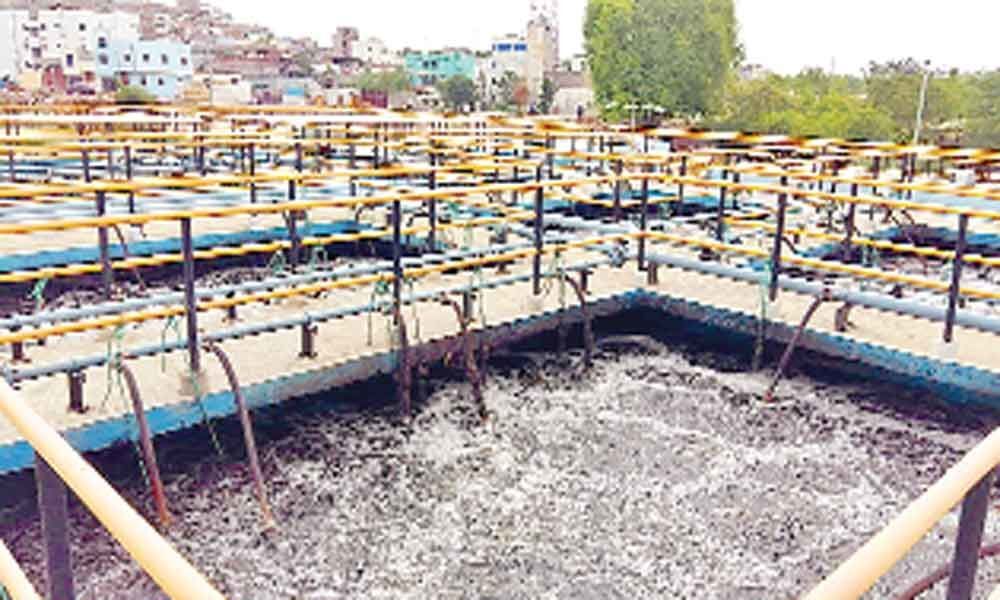Live
- MP BJP to celebrate former PM Vajpayee's birth anniversary on Dec 25
- Christmas Eve 2024: Heartwarming Messages To Share With Your Loved Ones
- PM Modi holds brainstorming session with economists in run-up to Budget
- “Telangana Ready to Support AI Technologies That Drive Social Impact,” says Special Chief Secy, Jayesh Ranjan at Woxsen University’s Future Tech Summit 2024
- Hero Motosports Team Rally Announces Squad For Dakar Rally 2025
- Two Men Found Dead In Parked Caravan In Kerala
- Mandhana moves closer to top spot in ODI, T20I rankings
- IND vs AUS Boxing Day Test 2024: Sam Konstas Debuts, Travis Head’s Fitness in Question
- Congress Challenges Election Rule Amendments In Supreme Court
- Jaishankar’s US Visit: Key Diplomatic Engagement Amid Leadership Transition
Just In
Despite Sewerage Treatment Plants, Mir Alam Lake getting clogged by effluents


The existing Sewerage Treatment Plants (STPs) around Mir Alam Lake remains ineffective, as their treating capacity is not maintaining the balance between the inflow of sewerage from surrounding areas and the volume of water treated on their premises.
Rajendranagar: The existing Sewerage Treatment Plants (STPs) around Mir Alam Lake remains ineffective, as their treating capacity is not maintaining the balance between the inflow of sewerage from surrounding areas and the volume of water treated on their premises.
For instance, the operational activity of one of the STP at Indra Nagar under Hassan Nagar, close to pillar no 258, the amount of treated water is no way close to what is actually flowing down to the water body.
"The treatment capacity of the STP is 5 Million Litres per Day (MLD), while the plant treats 2.5 MLD of filth per day, as per conservative estimates. The STP, which stands almost on a dried part of the lake, receives approximately 93.73 cubic metres of effluents per hour through the in-let route and the amount of inflow changes with the ebb and flows," said Manikanchan Hajra, the supervisor of the plant.
The STP was set up in 2017 to treat the effluents flowing in from the areas coming under the 4 km of radius around Mir Alam Lake. Attapur and Sulaiman Nagar are the areas that stand close to that part of the lake from where the sewerage flows down to the STP. Though the huge volume of the effluents from the surrounding upstream areas flow down into the lake directly from different directions, only a meagre amount of sewerage takes the route to the STP from where it gets treated and redirected into the water body.
It is also important to mention here that the big part of the upstream areas on the lake doesn't have a proper sewerage system to pass-on the filth directly to the STPs set up in the Mir Alam Lake.
"We could only be able to estimate the actual amount of sewerage that flows into the plant through the designated routes, but can't tell anything about the amount of filth that takes diverse routes to get mixed in the lake. We are confined to the operations that carried out within the premises of STP," added Manikanchan Hajra.
Sub contractor maintains STP
One more interesting fact is that the contract to run the STP was awarded to MEIL Balanagar but presently being operating by people associated with one Patlaru Association. It is said the Hyderabad Metropolitan Water Supply & Sewerage Board (HMWS&SB) has primarily awarded the contract to Megha Engineering & Infrastructure Limited at Balanagar for three years. However, the plant is presently being operating under the supervision of Patlaru Association while the staff being employed there are associated with Sri Sai Engineering Services. The contract period will come to an end in the year 2020. The plant has a total strength of 10 people including Fitter Cum Supervisor, Electricians, Operator and Helpers.
Effectiveness of STP
While the small amount of sewerage inflow coming from Attapur side reach to the plant for treatment, the untreated inflow coming from Shivrampally via Hassan Nagar is directly entering into the water body through a Nala (Anabranch) at Indranagar. Ironically, the treatment plant has two inlet routes to receive the overflowing sewerage from two different directions but only one inlet route – which is passing the effluent from Attapur and Sulaiman Nagar side was left open while the other one which carries the sewerage from Shivrampally via Hassan Nagar side has completely sealed.
"For those who watch the STP from outside could only guess that it's just a STP that treats the sewerage water to protect the water body from pollution however, when you enter to observe the operations going on inside the premises, you would find the whole picture other way around. At one side the effluent coming from Attapur and Sulaiman Nagar is getting treated that too in a meager amount while the big chunk of filth coming from Shivrampally directly entering into the water body without getting treated. In such a situation having a STP with a low capacity of operations becomes no worthwhile," said Mohammed Zaheeruddin, a social activist from Indranagar.
"More so, the treated water that was redirected to the water body is never appears as completely purified with its dark appearance and colour. It looks like the waste material and sludge remained persisting in the water being released into the lake after treatment. There is no much difference between the treated and untreated water that is being released into the water body," he added.

© 2024 Hyderabad Media House Limited/The Hans India. All rights reserved. Powered by hocalwire.com






